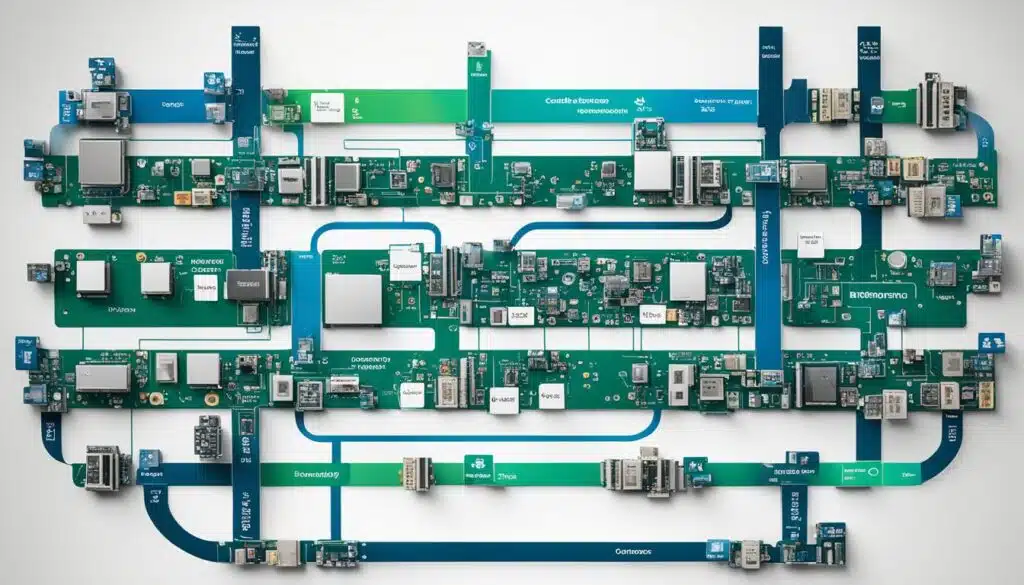In the world of web development, micro frontends are changing the game . They offer a new way to handle complex web applications. This approach lets developers think of a site or app as a mix of features. Each feature is owned by different teams, giving them the freedom to pick their own tools and libraries.
Benefits of micro frontends This method brings more flexibility, scalability, and efficiency to big projects in micro frontend approach. It’s a fresh take on building and maintaining web applications.
Key Takeaways
- Micro frontend architecture lets teams work and deploy independently, speeding up project delivery.
- It supports technology freedom, letting teams pick the best tools for their needs.
- Micro frontends make scaling and upkeep easier by breaking down the big frontend into smaller parts.
- This way, teams can be more flexible and innovative, meeting user needs better.
- Micro frontends also make it easier to handle problems, keeping the whole app running smoothly.
What is a Micro Frontend Architecture?
In web development, the micro frontend architecture is becoming popular as an alternative to old ways. It’s different from the old method where one big codebase does everything. A micro frontend is a Single Page Application (SPA) made up of many independent parts. Each part has its own life cycle.
Definition and Key Concepts
A micro frontend breaks a web app into separate parts. These parts work together but can be made and updated on their own. This makes it easier to change, grow, and work on the app faster. Each part focuses on a specific feature, using different tech and frameworks.
Difference from Monolithic Architecture
Micro frontend architecture is different from the old monolithic way. In monolithic, everything is one big unit. This makes it hard to grow and update the app. But, a micro frontend architecture lets you work on parts separately. This way, changing one part doesn’t mess with others.
| Monolithic Architecture | Micro Frontend Architecture |
|---|---|
| Single codebase | Multiple independent components |
| Tight coupling between components | Decoupled components with their own lifecycles |
| Difficult to scale and maintain | Highly scalable and maintainable |
| Slower development and release cycles | Faster development and release cycles |
Why Use a Micro Frontend Architecture?

The micro frontend architecture is great for big projects. It makes growing the development process easier. For instance, it’s super useful for a huge online store like Zalando. Here, different teams can work on their parts without messing with the whole site.
Also, micro frontends shine in web projects. They’re good because iOS and Android apps work similarly. This makes it easier to add or change things in the project. Teams can focus on their parts without slowing down the whole project.
Benefits for Medium to Large Projects
- Scalable development process
- Efficient for building large eCommerce websites
- Teams can work independently on components
Advantages for Web Applications
- Flexible and adaptable to dynamic web designs
- Easier to create or replace functionality on the fly
- Improved team productivity and collaboration
| Benefit | Description |
|---|---|
| Scalability | Micro frontends make growing the development process easy. They’re perfect for big projects. |
| Flexibility | They’re great for web apps. They let you easily add or change features. |
| Productivity | Micro frontends help teams work better together. They can focus on their parts without slowing down the project. |
“Micro frontends are a game-changer for medium to large web projects. They let teams work independently and efficiently on different parts of the application.”
Key Benefits of Micro Frontend Architecture

Micro-frontend architecture brings many benefits to web app development. It offers design and development flexibility. It allows for independent codebases. And it uses native browser-based communication instead of custom APIs.
Design and Development Flexibility
Micro-frontend architecture is very flexible. It doesn’t lock you into one technology stack. This means different teams can pick the tools they like best. It lets developers try new things and work faster, making apps more innovative and focused on users.
Separate Codebases
Breaking down big codebases into smaller pieces is a key benefit. Each team can work on its own codebase. This makes development, testing, and deployment easier. It also means less chance of team conflicts and more focused work on features.
Favors Native Browser over Custom APIs
Using native browser events and communication is preferred over custom APIs in micro-frontends. This makes things simpler and faster. It works well even on slower internet or older browsers, improving performance.
| Benefit | Description |
|---|---|
| Micro Frontend Flexibility | Micro-frontend architecture offers greater design and development flexibility, allowing teams to use the tools and frameworks that best suit their needs. |
| Independent Codebases | Micro-frontends enable teams to maintain separate codebases, promoting agility, reducing cross-team conflicts, and allowing for more focused feature development. |
| Browser-based Communication | Micro-frontends favor the use of native browser events and communication mechanisms, leading to quicker rendering and improved performance. |
“Micro-frontend architecture empowers teams to innovate more freely, while maintaining a coherent user experience across the application.”
Freedom to Innovate
A micro-frontend architecture gives development teams the freedom to choose their project’s technology stack. They don’t have to stick to one big codebase. Instead, they can pick the tools and frameworks that fit their business needs best.
This freedom to innovate lets teams use the newest technologies and cutting-edge tools in their projects. They don’t have to stick to a certain technology choice. This way, they can always improve their apps and give users the best experience.
With a micro-frontend architecture, teams can use the latest in web tech, frameworks, and libraries. This boosts their freedom to innovate and helps them move their projects forward.
“The independence of microservices and micro-frontend architecture allows development teams to pick and choose the technologies they want to use, choosing the tools that best meet the requirements of their projects and business domains.”
| Benefit | Description |
|---|---|
| Freedom to Innovate | Teams can choose the technologies and tools that best fit their project’s needs, without being bound to a specific technology stack. |
| Cutting-edge Tools | Developers can incorporate the latest advancements in web technologies, frameworks, and libraries to enhance their applications. |
| Technology Choice | The independence of micro-frontend architecture allows for greater flexibility in technology selection, enabling teams to stay ahead of the curve. |
Fault Isolation and Resilience
Micro-frontend architecture makes sure a problem in one part doesn’t bring down the whole system. It keeps the service running smoothly even when some parts fail. This means users can still have a good experience, even if some parts of the app don’t work perfectly.
Micro-frontends work like separate pieces that don’t affect each other. So, if one piece has a bug, it won’t mess up the whole app. This keeps the app running smoothly, even when there are problems.
This way of working is key for fault isolation. It helps make robust applications that handle problems well. When issues pop up, users can still use the parts that work, keeping their experience good.
Breaking the app into smaller parts makes fixing problems easier for developers. This means less trouble for users and a more reliable app micro frontends offer. It leads to a better and more consistent experience for everyone.
Scalability and Faster Build Times

A micro frontend architecture makes apps more scalable. It lets you easily change the size of parts of the system. This way, teams can work on specific parts without being tied down by a huge codebase.
This approach also means faster build times thanks to concurrent development across teams. As teams work on their parts, the whole project moves faster. This is key in today’s fast world, where staying ahead means moving quickly.
“Micro frontend architecture empowers development teams to work autonomously, leading to faster release cycles and more innovative solutions.”
Micro frontends bring flexibility and scalability term “micro frontends. They let teams quickly meet new market needs and user wants. By breaking the app into smaller parts, teams can try new things and update without slowing down the whole system. This is a big win for making apps scalable and getting things done faster.
Technology Agnosticism

A micro frontend architecture is great because it doesn’t rely on any specific technology. This lets different languages and frameworks like JavaScript, React, Vue, Angular, work together smoothly. You don’t have to worry about setting up these technologies because the micro frontend handles it easily.
This technology agnostic method has many benefits:
- Support for various frameworks and technologies, letting teams pick the best tools.
- No setup requirements for adding new technologies, as the architecture does it.
- More flexibility in choosing technologies, helping teams adapt to new trends.
Using this technology agnostic approach lets organizations use the best parts of different frameworks and languages. This makes web applications more innovative and efficient. It also helps development teams stay agile and meet the changing needs of the business, leading to better user experiences.
| Feature | Benefit |
|---|---|
| Technology Agnostic | Supports various frameworks and languages, no setup requirements |
| Flexible Integration | Allows seamless integration of different technologies |
| Adaptable to Change | Enables teams to choose the best tools for the job and respond to evolving needs |
By using the technology agnostic nature of micro frontends, organizations can achieve more innovation, flexibility, and efficiency in their web development.
Autonomous and Cross-Functional Teams

The micro-frontend architecture lets teams work on their own, focusing on specific parts of a website. This way, companies can tackle the complex front-end building process better. It helps when designers and engineers don’t always work well together.
With micro-frontends, teams can focus on their own features or parts. This leads to better communication and a clear focus on details. They can make decisions and try out new ideas quickly, without waiting for others or worrying about the project’s timeline.
These teams are great because they mix different skills and views. Designers, developers, and product managers work together well. This means a better mix of user experience, functionality, and what the business needs. It results in solutions that are more complete and focused on the user.
| Benefit | Description |
|---|---|
| Autonomy | Micro-frontend teams can work independently on specific features or components, without being constrained by the overall project timeline or dependencies on other teams. |
| Cross-Functionality | Teams comprise designers, developers, and product managers, ensuring a seamless integration of user experience, functionality, and business requirements. |
| End-to-End Development | The cross-functional nature of the teams enables them to take ownership of the entire development process, from design to deployment, for their respective components. |
The micro-frontend architecture helps companies build web applications that are agile, focused on the user, and can grow micro frontend without easily use the same framework. It’s all about making teams work together better and giving them the freedom to do their best work .
Maintainability and Reusability
Micro-frontend architecture makes it easier to keep and reuse code. It breaks a big app into smaller parts, making it simpler to handle and update. Each part, or micro-frontend, has its own code, making it easier to manage.
This way, you can use the same piece of code in many places. This saves time and cuts down on repeated work. It’s a big plus of micro-frontend architecture.
| Benefit | Description |
|---|---|
| Maintainable Codebases | Micro-frontends help create code that’s easy to keep up with and update. It makes the job simpler over time. |
| Reusable Components | Sharing components across different parts of the app makes things more efficient. It also means less work is repeated. |
| Modular Design | This approach breaks the app into smaller, easier-to-handle parts. It makes it easier to keep the app running smoothly. |
Using maintainable codebases, reusable components, and modular design makes building and keeping up with complex web apps better. It leads to apps that last longer and have less technical problems.
Micro Frontend Architecture Best Practices
To make a micro frontend architecture work well, follow best practices for success and upkeep microservices and micro frontends. Focus on setting clear boundaries which comes to micro and reducing dependencies between micro frontends.
Defining Clear Boundaries
It’s key to set clear boundaries for each micro frontend. This means knowing what functionality and user interface each one has. Make sure there’s a clear public API surface area. This way, you keep each micro frontend separate and can work on them independently.
Minimizing Dependencies
To make your micro frontend architecture more flexible and scalable, reduce dependencies. Manage shared resources like UI components and data models carefully. This ensures each micro frontend works well on its own. Less coupling means your web app is more resilient.
Following these best practices helps you get the most out of micro frontend architecture. You’ll enjoy design and development flexibility, fault isolation, and technology agnosticism. This leads to a web app that’s easier to maintain and grow.
Handling Routing in Micro Frontends
Dealing with micro frontend architecture can be tough, especially when it comes to routing. Each micro frontend acts like its own HTTP server, with many routes in different places. This makes managing traffic flow key.
There are two main ways to handle routing in micro frontends. One is using a reverse proxy. This sends traffic to the right micro frontend based on the URL. The other is a central router. It defines all routes and sends traffic to the correct micro frontend.
Choosing the best method depends on your app’s needs and complexity. You should think about how many micro frontends you have and how complex the URL paths are. This will help you pick the right routing strategy.
Reverse Proxy Routing
A reverse proxy sits between the client and the micro frontends. It directs traffic to the right micro frontend based on the URL. This method gives you control over routing from one place. It makes managing URL paths and micro frontends easier.
Central Router Routing
The central router method puts all routes in one place and sends requests to the right micro frontend. It’s good for apps with lots of micro frontends or complex URLs. It keeps routing organized and cohesive.
Choosing between a reverse proxy or a central router for micro frontend routing depends on your project’s needs. You might need to try both to see which works best for you.
“Effective routing is the backbone of a successful micro frontend architecture, enabling seamless navigation and a cohesive user experience.”
Potential Pitfalls and Challenges
The micro frontend architecture has many benefits but also faces challenges. Managing multiple, independent applications can make things more complex. This complexity is a big concern for organizations.
The micro frontend challenges include tight dependencies between applications. This makes it hard to update one app without affecting others. It can limit flexibility and scalability, causing problems across the system.
Another issue is latency. Since each app talks to others, the network can slow things down, especially in busy situations. This can hurt the user experience and system performance.
The increased complexity of micro frontends also makes them harder to keep up and fix. Developers need to know a lot about each app and how they work together to solve problems.
To overcome these micro frontend challenges, it’s important to have good communication and clear rules. Reducing tightly coupled dependencies between components is key. Also, having strong deployment and monitoring plans helps keep the system reliable and fast.
“Micro frontends can be a powerful architectural approach, but they also come with their own set of challenges that must be carefully considered and addressed.”
| Potential Pitfall | Description |
|---|---|
| Increased Complexity | Managing multiple, independent applications and components can lead to a more complex system, making it challenging to maintain and debug. |
| Tightly Coupled Dependencies | Changes or updates to one application can have unintended consequences on the entire system due to the interdependencies between components. |
| Latency and Performance | The network overhead from communication between applications can introduce latency and negatively impact the user experience. |
Also Read : What Is The Role Of Robotics In Various Industries?
Conclusion
Micro frontend architecture is a strong way to build web applications. It lets developers see a site or app as a mix of features from different teams frontend code. This method breaks a big frontend into smaller parts micro frontends provide. It brings many advantages like more flexibility, separate code, and better scalability microservices architecture.
But, making micro frontend work well needs careful planning and clear rules. It’s important to handle challenges like more complexity and tight connections between parts. By linking it to business goals, companies can fully use its benefits. This leads to web apps that are easier to maintain and more innovative.
In short, using micro frontend architecture boosts web development in many ways. It makes building web experiences more flexible and resilient. By using this approach, companies can create dynamic web sites that meet user and market needs better.
FAQs
Q: What are the benefits of implementing micro frontends in your application?
A: Implementing micro frontends allows for a modular approach to frontend development, where different parts of the application can be developed, tested, and deployed independently. This leads to easier maintenance, scalability, and flexibility in the long run.
Q: How can you use micro frontends in your web development project?
A: You can use micro frontends to divide your frontend application into smaller, self-contained modules that can be developed by separate teams using different technologies. These modules can then be integrated into the overall application seamlessly.
Q: What is the concept of module federation in the context of micro frontends?
A: Module federation is a feature in modern JavaScript frameworks that enables sharing code between different micro frontends without having to duplicate it. This helps in reducing redundancy and improving the overall performance of the application.
Q: How do micro frontends differ from a traditional frontend monolith?
A: Micro frontends approach the frontend development by breaking down the application into smaller, independent parts, whereas a traditional frontend monolith relies on a single, monolithic codebase for the entire application. Micro frontends allow for better maintainability, scalability, and agility.
Q: What are the types of micro frontends that can be implemented in a frontend application?
A: There are various types of micro frontends, such as standalone micro frontends, shell, composition, integration, and hybrid micro frontends. Each type serves a different purpose in the architecture of a frontend application monolithic frontend.
Q: How do micro frontends work with microservices in an application?
A: Micro frontends and microservices are complementary architectural patterns that promote scalability, agility, and maintainability in a web application. Micro frontends handle the frontend part, while microservices handle the backend logic, creating a modular and efficient application structure.
Q: What are some best practices to follow when implementing micro frontends in a project?
A: Some best practices include defining clear boundaries between micro frontends, using a common design system for consistency, implementing lazy loading for improved performance, and establishing robust communication channels between micro frontends.





